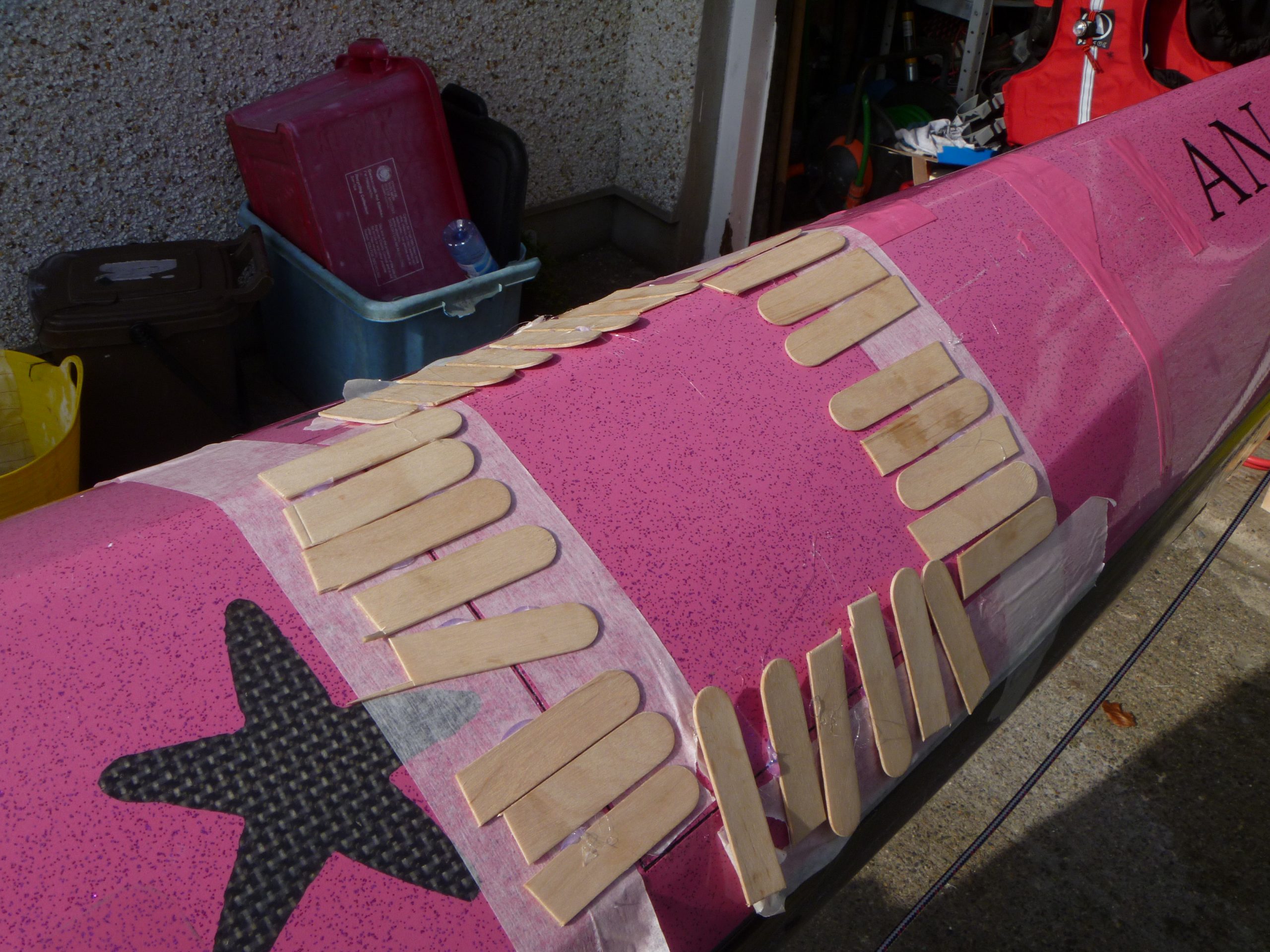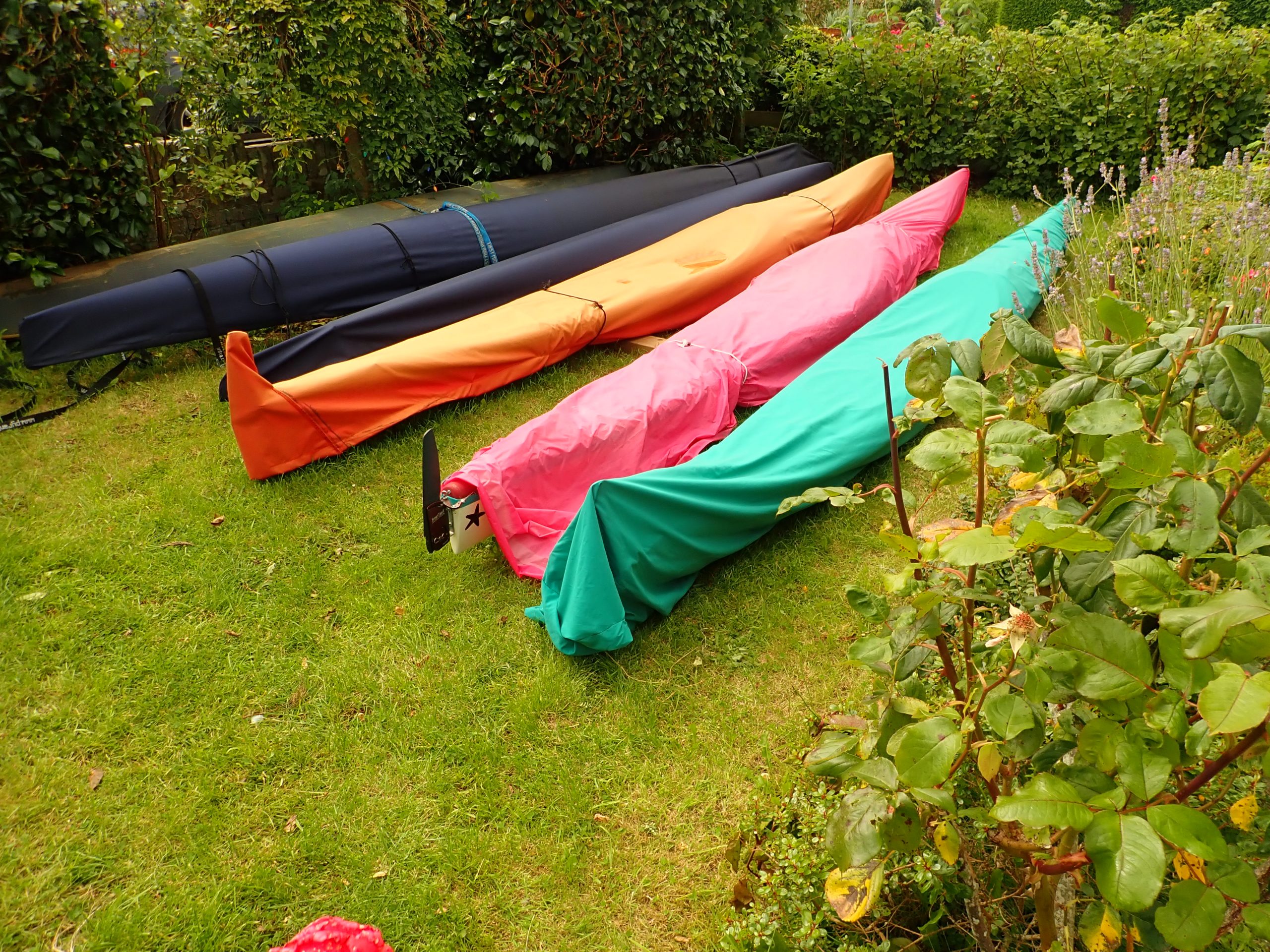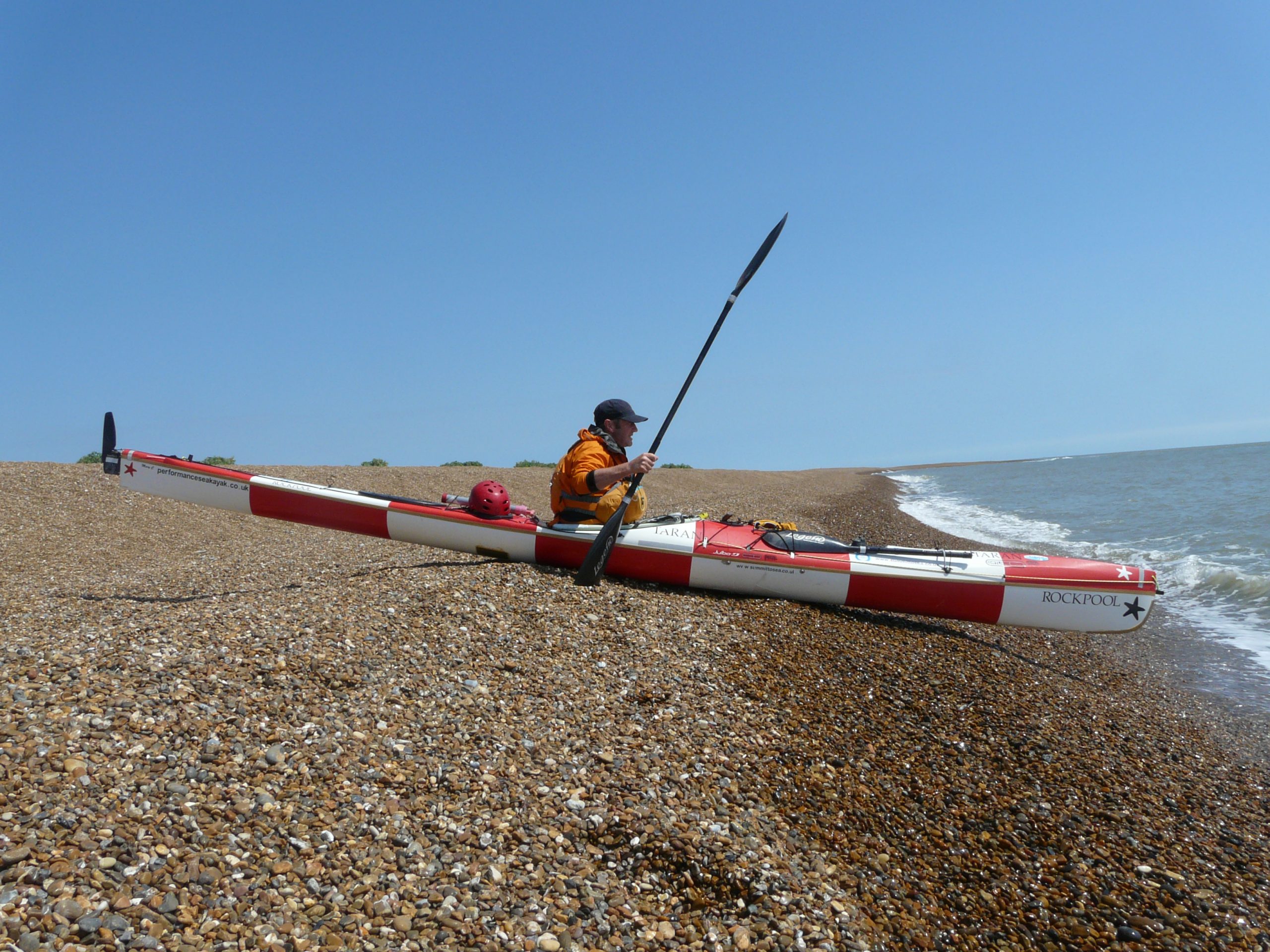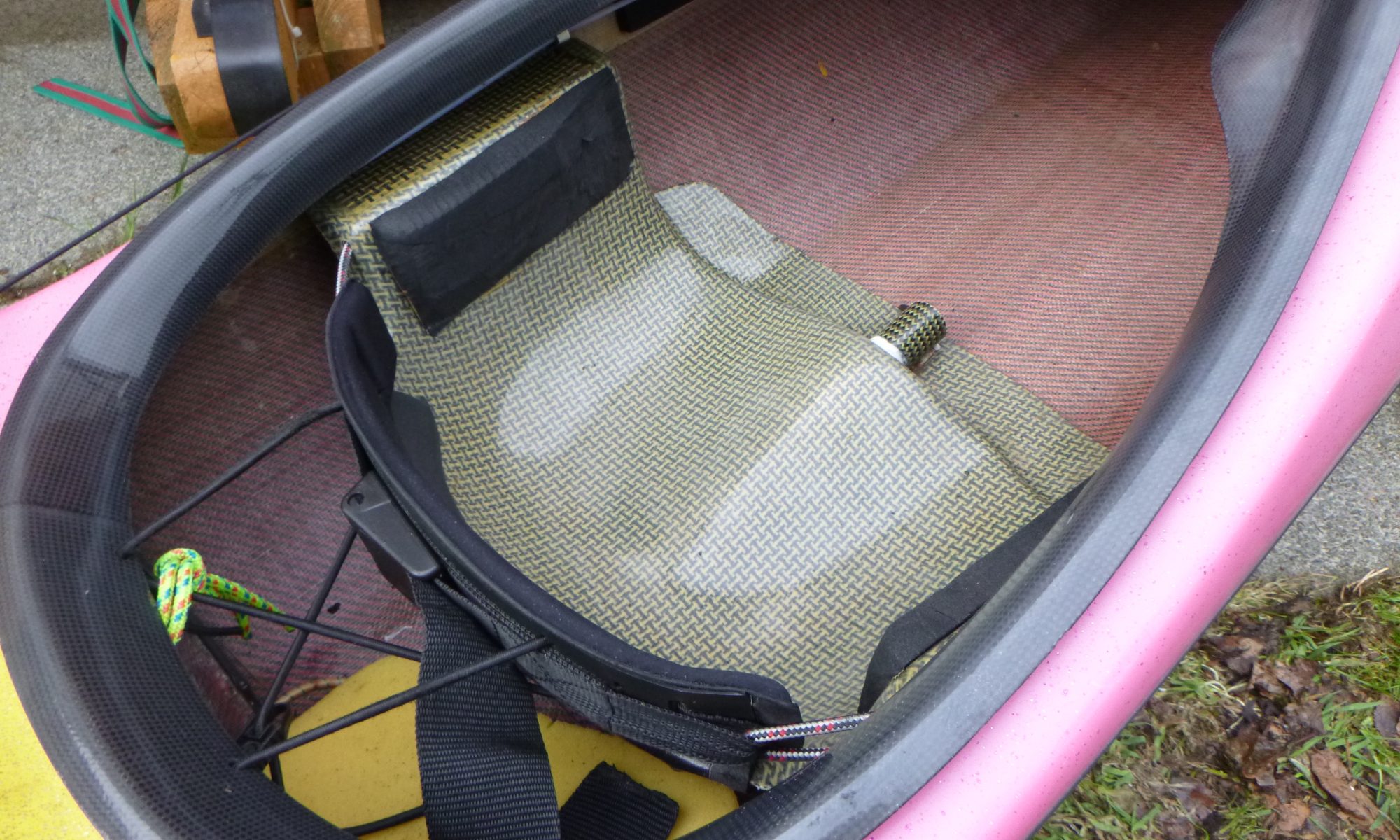Standard Construction for most sea kayaks is Polyester Resin with Chopped Strand Mat (CSM – or ‘fibreglass’) – a ‘glass’ kayak.
Polyester/CSM combination is easy to work with from a manufacturers point of view and relatively cheap.
It provides a tough, stiff and solid kayak, though to do this it requires enough material to make it generally rather heavy.
Polyester/Aramid fabrics (Diolen, Kevlar, Dyneema etc) are usually combined with epoxy resins. These man-made fabrics tend to have better tear resistance than CSM. When combined in a hybrid with a ‘stiffener’ fabric (or weave), such as ‘carbon fibre’ and a matrix of epoxy resin, these can provide similar stiffness to CSM for a lower weight. The most common example of this would be the Kevlar/Carbon hybrid fabric (kev/carb), though there are numerous alternatives.
Because these materials can provide similar stiffness for a lower weight, the manufacturer can in turn provide a lighter boat. And this weight saving can be significant – good stuff!
Except, of course there is a catch – or actually a few catches.
Weight:
The ‘same stiffness for less weight’ can also be read as ‘same stiffness for less material’. This tends to make the boats less ‘robust’ or less ‘tough’. Manufactured well they are still seaworthy of course – it’s just a different kind of seaworthy. They require a different kind of handling and looking after.
Look at it this way: a 28 kg ‘glass’ CSM boat should be a fairly solid boat. Make a 28 kg kev/carb boat and it should be be even more solid. However the catch is that for a comparable stiffness the kev/carb boat is unlikely to match that 28 kg figure, it will/should be lighter, perhaps substantially so. That’s the point.
However that ‘missing’ material makes the boat less ‘tough’ when it comes to taking the knocks. It will paddle fine, it should be rigid, but it is not as ‘robust’ – you don’t want to be dragging it up the beach every trip, grinding it up the slipway or making regular rock landings – it won’t last.
People misunderstand a little that a ‘Kevlar’ boat is ‘bulletproof’, they expect their new carbon-fibre dream-machine to be super bomb-proof. They’ve paid a premium after all.

But that premium is to save weight. If the boat was the same weight then it should, all things being equal, be more solid than CSM for the same weight. But to say once again, the point is that it is unlikely to be the same weight (and hence toughness) – just a similar rigidity for less weight. We’ve laboured the point now.
If you want to surf your boat at speed up boulder beaches, or seal launch from a gravelly beach, or do rocky landings, or lots of rescue work – or basically any paddling that involves regular crunchy-boat-contact, then you want a polyester/CSM boat (or even rotomoulded) – it will take the knocks much better.
A kev/carb boat needs looking after with a little more care, this is the price you pay for the weight saving.
As an aside, I have found that Epoxy boats are more susceptible to sunlight degradation on the whole too. Like vampires, they are best kept away from sunlight.

Construction:
Lightweight constructions are more likely to use methods such as ‘vacumn-bagging’ or infusion. These methods aim to remove excess resin/use the minimum amount required to provide a strong and uniform lay-up. They also use atmospheric pressure to consolidate the laminate layers to minimise voids and provide a more uniform lay-up than hand lay-up methods. Once again the the worth of the price premium is up to you.
Handling:
The weight you save won’t necessarily make the boat any faster, that’s a wide-ranging conversation in itself. However lighter will make it more responsive. And to some paddlers this is as good. The weight saving is shared more or less throughout the length of the boat, so that means the ends have lower inertia too, hence they respond to corrections (turn strokes) easier/quicker. So the boat will feel more responsive and ‘livelier’, it will be easier to turn and correct.
The downside is that it will also respond easier to external ‘corrections’ i.e. wind and waves. People unused to lighter boats often complain that they find them ‘twitchy’ or they feel they get thrown about more. In a way that’s the point, a good paddler will take a light boat over a heavy boat any day – because the boat feels more ‘alive’ and they will embrace that liveliness in the handling.
A light boat also accelerates quicker than a heavy one, making the boat feel ‘faster’. (Bear in mind too that every stroke is an acceleration stroke.) Though some may argue that the acceleration advantage may be more significant for the racing world rather than sea kayaking. Debate at will there…
An often overlooked, though significant, advantage of a lighter boat too is the off-the-water handling – it is much easier to load on to vehicles, carry to the water etc. Especially when solo paddling.
And, to be really frank, it has to be said that many people who are prepared to spend an extra £1000 to save a few kilos on boat weight, should just look in the mirror and see how much extra they are carrying. Many could save the weight, the money and do themselves a favour at the same time, by getting a lighter body before a lighter boat. (Been there)
Personally, my boats are various combinations of epoxy and ‘man-made’ fabrics. They do the job. I know how to look after them and I have made them last, it’s not hard. (Both my UK circumnav boats were epoxy boats.) However, treat them roughly and you may find they suffer for it. If you have a racing background you should not have a problem looking after a lightweight construction sea kayak. Though if your background does not previously involve lightweight boats then you may find you have to adjust your handling and paddling habits (and expectations) a little.

A sub-note, some manufacturers and some paddlers do not like epoxy resins. Some manufacturers avoid them because they are concerned by health implications of working with the resins. I have known race paddlers who have put health problems down to allergies to these resins. However these were rare cases. I’ve been paddling epoxy for 30+ years with no known side-effects (twitch – twitch!)
So to sum up:
Polyester/CSM is cheap and cheerful, tough but heavy.
Epoxy/Kev-carb – is more expensive and needs treating with more care, though it provides a (sometimes considerable) weight saving.
Your lightweight construction is seaworthy and should be of similar stiffness, but it is not as ‘tough’.
Lightweight constructions are a realistic choice for sea kayaking, however they are likely to be more expensive and require a different approach to handling and paddling.
by John Willacy
